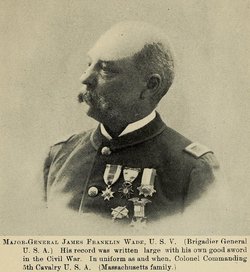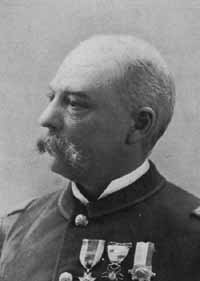James' father, Senator Benjamin F. Wade, was a Radical Republican senator from Ohio during the Civil War, and a harsh critic of President Abraham Lincoln and his successor, Andrew Johnson. James married Clara Lyon in Ashtabula County on 27 February 1866. They had at least three children: Benjamin Franklin, John Parsons and Clara Lyon.
James was commissioned a 1st Lieutenant in the 3rd U.S. Cavalry Regiment on 14 May 1861. He earned a brevet promotion to Captain after the Battle of Brandy Station in June 1863. He was appointed Lieutenant Colonel of the 6th U.S. Colored Cavalry Regiment on 1 May 1864, and in September 1864 was promoted Colonel and commander of the Regiment. He later received brevet Regular Army promotions to Major, Lt. Col. and Colonel, and was breveted Brigadier General of Volunteers in March 1865 for gallant service in the campaign in southwestern Virginia.
In July 1866, James was commissioned, at the Regular Army rank of Major, in the newly established 9th U.S. Cavalry Regiment. The 9th was one of the "Buffalo Soldier" regiments, which became famous for their service on the frontier. He was promoted Lieutenant Colonel in the 10th U.S. Cavalry in March 1879. James left the buffalo soldiers with promotion to Colonel of the 5th U.S. Cavalry Regiment in April 1887. He served ten years as the commander of this Regiment before being promoted Brigadier General in May 1897. At the start of the Spanish-American War in 1898, he was promoted Major General of Volunteers and assumed command of the Third Army Corps at Camp Thomas, Chickamauga, Georgia. Following the armistice in August, he was a leader of the Cuban Evacuation Committee to oversee the removal of Spanish forces from Cuba and Puerto Rico.
James then returned to his Regular Army rank and the command of the Department of Dakota. In 1901 he was placed in command of the Department of Southern Luzon in the Philippines, and in 1903 was promoted to the permanent rank of major general and placed in command of the Division of the Philippines. In 1904 he returned to the United States as commander of the Division of the Atlantic at Fort Jay on Governors Island in New York City. In his final posting, James was in charge of all U.S. Army posts and activity east of the Mississippi River, serving until his retirement on 14 April 1907, after 46 years of service. He returned to Jefferson, where he worked as a banker and served on the school board.
James' father, Senator Benjamin F. Wade, was a Radical Republican senator from Ohio during the Civil War, and a harsh critic of President Abraham Lincoln and his successor, Andrew Johnson. James married Clara Lyon in Ashtabula County on 27 February 1866. They had at least three children: Benjamin Franklin, John Parsons and Clara Lyon.
James was commissioned a 1st Lieutenant in the 3rd U.S. Cavalry Regiment on 14 May 1861. He earned a brevet promotion to Captain after the Battle of Brandy Station in June 1863. He was appointed Lieutenant Colonel of the 6th U.S. Colored Cavalry Regiment on 1 May 1864, and in September 1864 was promoted Colonel and commander of the Regiment. He later received brevet Regular Army promotions to Major, Lt. Col. and Colonel, and was breveted Brigadier General of Volunteers in March 1865 for gallant service in the campaign in southwestern Virginia.
In July 1866, James was commissioned, at the Regular Army rank of Major, in the newly established 9th U.S. Cavalry Regiment. The 9th was one of the "Buffalo Soldier" regiments, which became famous for their service on the frontier. He was promoted Lieutenant Colonel in the 10th U.S. Cavalry in March 1879. James left the buffalo soldiers with promotion to Colonel of the 5th U.S. Cavalry Regiment in April 1887. He served ten years as the commander of this Regiment before being promoted Brigadier General in May 1897. At the start of the Spanish-American War in 1898, he was promoted Major General of Volunteers and assumed command of the Third Army Corps at Camp Thomas, Chickamauga, Georgia. Following the armistice in August, he was a leader of the Cuban Evacuation Committee to oversee the removal of Spanish forces from Cuba and Puerto Rico.
James then returned to his Regular Army rank and the command of the Department of Dakota. In 1901 he was placed in command of the Department of Southern Luzon in the Philippines, and in 1903 was promoted to the permanent rank of major general and placed in command of the Division of the Philippines. In 1904 he returned to the United States as commander of the Division of the Atlantic at Fort Jay on Governors Island in New York City. In his final posting, James was in charge of all U.S. Army posts and activity east of the Mississippi River, serving until his retirement on 14 April 1907, after 46 years of service. He returned to Jefferson, where he worked as a banker and served on the school board.
Family Members
Sponsored by Ancestry
Advertisement
Records on Ancestry
Advertisement
















